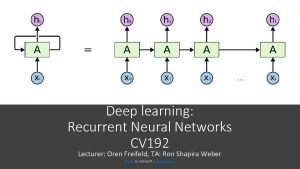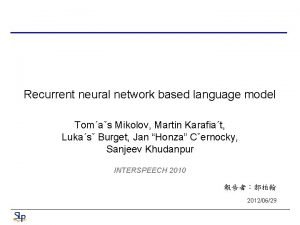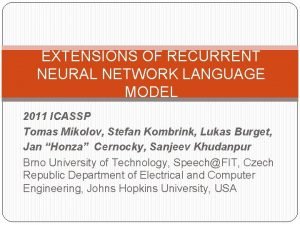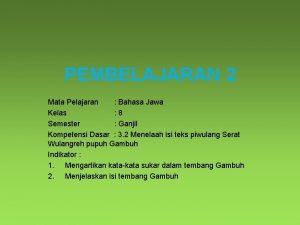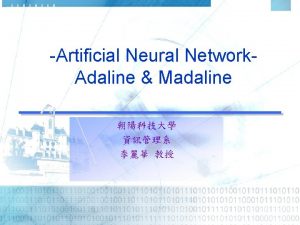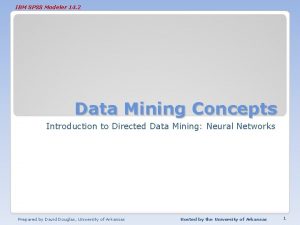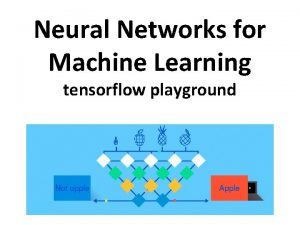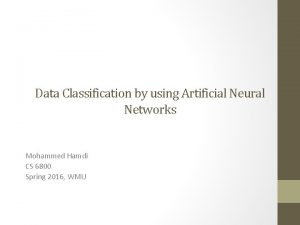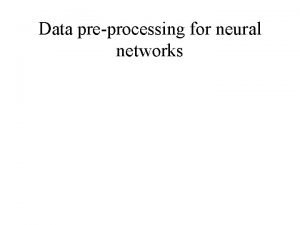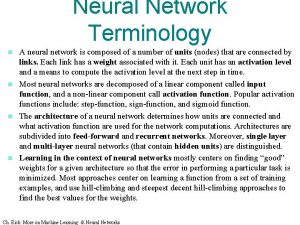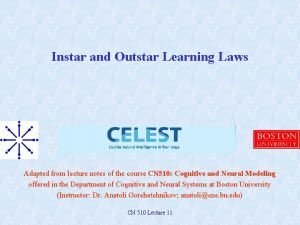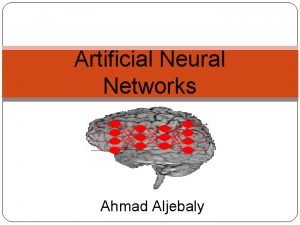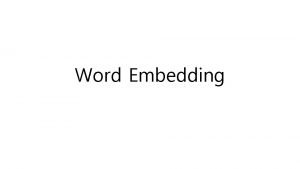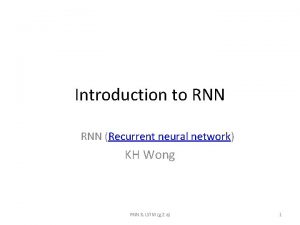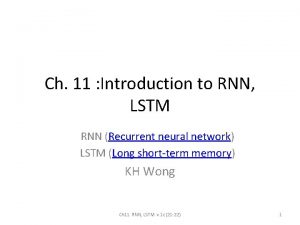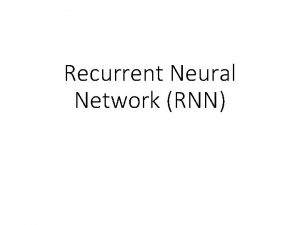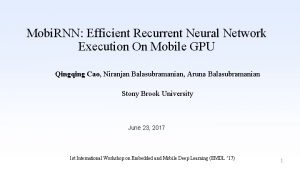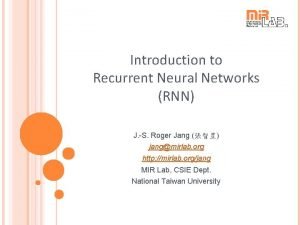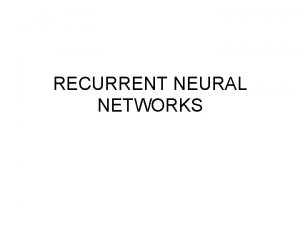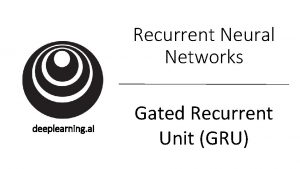Recurrent neural network RNN KH Wong RNN v











![• Whx=[Whx(1), Whx(2), Whx(3), Whx(4)] Inside A : 3 neurons at time t • Whx=[Whx(1), Whx(2), Whx(3), Whx(4)] Inside A : 3 neurons at time t](https://slidetodoc.com/presentation_image_h/16d8eea3d9f775227e731238014de4ab/image-12.jpg)





- Slides: 17

Recurrent neural network RNN KH Wong RNN v. 0. a 1

Ch. 11 : Introduction to RNN, LSTM RNN (Recurrent neural network) LSTM (Long short-term memory) KH Wong Ch 11. RNN, LSTM v. 9 f 2

Overview • Introduction • Concept of RNN (Recurrent neural network) ? Ch 11. RNN, LSTM v. 9 f 3

Introduction • RNN (Recurrent neural network) is a form of neural networks that feed outputs back to the inputs during operation • Materials are mainly based on links found in https: //www. tensorflow. org/tutorials Ch 11. RNN, LSTM v. 9 f 4

Concept of RNN (Recurrent neural network) concept Ch 11. RNN, LSTM v. 9 f 5

RNN Recurrent neural network • Xt= input at time t • ht= output at time t • A=neural network • The loop allows information to pass from t to t+1 • reference: • http: //colah. github. io/posts/2015 -08 Understanding-LSTMs/ Ch 11. RNN, LSTM v. 9 f 6

The Elman RNN network • An Elman network is a three-layer network (arranged horizontally as x, y, and z in the illustration), with the addition of a set of "context units" (u in the illustration). The middle (hidden) layer is connected to these context units fixed with a weight of one. [25] At each time step, the input is fed-forward and then a learning rule is applied. The fixed back connections save a copy of the previous values of the hidden units in the context units (since they propagate over the connections before the learning rule is applied). Thus the network can maintain a sort of state, allowing it to perform such tasks as sequence-prediction that are beyond the power of a standard multilayer perceptron https: //en. wikipedia. org/wiki/Recurrent_ne ural_network Ch 11. RNN, LSTM v. 9 f 7

RNN unrolled But RNN suffers from the vanishing gradient problem, see appendix) • Unroll and treat each time sample as an unit. An unrolled RNN Problem: Learning long-term dependencies with gradient descent is difficult , Bengio, et al. (1994) LSTM can fix the vanishing gradient problem Ch 11. RNN, LSTM v. 9 f 8

Different types of RNN • (1) Vanilla mode of processing without RNN, from fixed-sized input to fixedsized output (e. g. image classification). • (2) Sequence output (e. g. image captioning takes an image and outputs a sentence of words). • (3) Sequence input (e. g. sentiment analysis where a given sentence is classified as expressing positive or negative sentiment). • (4) Sequence input and sequence output (e. g. Machine Translation: an RNN reads a sentence in English and then outputs a sentence in French). • (5) Synced sequence input and output (e. g. video classification where we wish to label each frame of the video). http: //karpathy. github. io/2015/05/21/rnn-effectiveness/ Output layer Hidden layer (recurrent layer) Input layer (1) (2) (3) RNN v. 0. a (4) (5) 9

A simple RNN (recurrent Neural network) for sequence prediction • Predict the next character game • First: define the characters. The dictionary has 4 characters, one-hot representation • If PIG is received, the prediction is S • This mechanism can be extended to machine translation One hot P I G S X 1 1 0 0 0 X 2 0 1 0 0 X 3 0 0 1 0 X 4 0 0 0 1 RNN v. 0. a 10

A simple RNN (recurrent Neural network) for sequence prediction • Unroll an RNN: If PIG is received, the prediction is S • Tanh(Whx*X + Whh(1)*ht-1(1) + bias(1))=ht(1) Note: • Tanh(Whx*X + Whh(2)*ht-1(2) + bias(2))=ht(2) • Tanh(Whx*X + Whh(3)*ht-1(3) + bias(3))=ht(3) • A is an RNN with 3 neurons : enter PIG step by step to Xt at each time t , ht will give S automatically For softmax, see http: //www. cse. cuhk. edu. hk/~khwong/www 2/cmsc 5707/5707_likelihood. pptx External output ‘I’ Output layer (Softmax) Hidden (recurrent) layer Input layer ht=1 ht A Xt ht-1 = tanh Xt=1= ‘P’ ‘G’ Output layer (Softmax) ht=2 tanh Xt=2= ‘I’ RNN v. 0. a https: //www. analyticsvidhya. com/blog/2017/12/introduction-to-recurrent-neural-networks/ ‘S’ Output layer (Softmax) ht=3 tanh Xt=3= ‘G’ Time-unrolled diagram of the RNN 11
![WhxWhx1 Whx2 Whx3 Whx4 Inside A 3 neurons at time t • Whx=[Whx(1), Whx(2), Whx(3), Whx(4)] Inside A : 3 neurons at time t](https://slidetodoc.com/presentation_image_h/16d8eea3d9f775227e731238014de4ab/image-12.jpg)
• Whx=[Whx(1), Whx(2), Whx(3), Whx(4)] Inside A : 3 neurons at time t • X=[X(1), X(2), X(3), X(4)]’ • Whh=[Whh(1), Whh(2), Whh(3)]’ • Bias=[bias(1), bias(2), bias(3)]’ ht-1(3) Whh(3) Tanh(Whx*X+Whh(3)*ht-1(3)+bias(3))=ht(3) Whx(2) Whx(1) X(1) ht-1(2) X(3) Whx(4) X(4) Whh(2) Tanh(Whx*X+Whh(2)*ht-1(2)+bias(2))=ht(2) Whx(1) ht-1(1) X(2) Whx(3) X(2) X(1) Whh(1) Whx(3) X(3) Whx(2) Whx(3) ht(2) Whx(4) X(4) Tanh(Whx*X+Whh(1)*ht-1(1)+bias(1))=ht(1) Whx(1) ht(3) ht(1) Whx(4) 12 RNN v. 0. a X(1) X(2) X(3) X(4)

• • • • • Exercise RNN 1 a: Numerical examples whx=[0. 287027 0. 84606 0. 572392 0. 486813 0. 902874 0. 871522 0. 691079 0. 18998 0. 537524 0. 09224 0. 558159 0. 491528] why=[0. 37168 0. 974829459 0. 830034886 0. 39141 0. 282585823 0. 659835709 0. 64985 0. 09821557 0. 332487804 0. 91266 0. 32581642 0. 144630018] bias=0. 567001*[1 1 1]' %random init. val whh=0. 427043*[1 1 1]'%random init. val ht(: , 1)=[0 0 0]' %init val, assume zero ht(: , t+1)=tanh(whx*in(: , t)+whh. *ht(: , t)+bias) ===== to verify===== for the first nueron , t=1 ht(1, t+1)=tanh([0. 287027 0. 84606 0. 572392 0. 486813]*[1 0 0 0]'+0*0. 427043+0. 567001) = 0. 6932 ht(2, t+1)=tanh([0. 902874 0. 871522 0. 691079 0. 18998]*[1 0 0 0]'+0*0. 427043+0. 567001) =0. 8996 Exercise 8 a, find ht(3, t+1)=_____? ht(1, t+2)=_____? ht(2, t+2)= _____? Exercise 8 b, find output of the output layer at time t RNN v. 0. a 13

Matlab demo: Answer RNN 1 a • %rnn 2. m • %https: //stackoverflow. com/questions/50050056/simple-rnn-exampleshowing-numerics • %https: //www. analyticsvidhya. com/blog/2017/12/introduction-torecurrent-neural-networks/ • clear • in_P=[1 0 0 0]' • 0 0. 6932 0. 9365 0. 9120 • in_I=[0 1 0 0]' • 0 0. 8996 0. 9491 0. 9307 • in_G=[0 0 1 0]' • in_S=[0 0 1 0]' • in=[in_P, in_I, in_G, in_S] • y_out = • whx=[0. 287027 0. 84606 0. 572392 0. 486813 • 0 1. 8003 1. 9061 1. 9898 • 0. 902874 0. 871522 0. 691079 0. 18998 • 0. 537524 0. 09224 0. 558159 0. 491528] • 0 1. 0548 1. 1378 1. 2111 • why=[0. 37168 0. 974829459 0. 830034886 • 0 0. 8055 0. 9553 0. 9819 • 0. 39141 0. 282585823 0. 659835709 • 0 1. 0417 1. 2742 1. 2651 • 0. 64985 0. 09821557 0. 332487804 • 0. 91266 0. 32581642 0. 144630018] • softmax_y_out = • bias=0. 567001*[1 1 1]' %random init val • 0 0. 4324 0. 4198 0. 4332 • whh=0. 427043*[1 1 1]'%random init val • 0 0. 2052 0. 1947 0. 1988 • ht(: , 1)=[0 0 0]' %init val, assume zero • for t = 1: length(in)-1 % • %https: //stackoverflow. com/questions/50050056/simple-rnn 0 0. 1599 0. 1622 0. 1581 • print result ========== • ht = Time • 0 0. 8021 0. 7623 0. 8958 RNN v. 0. a example-showing-numerics • • %https: //www. analyticsvidhya. com/blog/2017/12/introduction-to 0 0. 2025 0. 2232 0. 2099 t recurrent-neural-networks/ ht(: , t+1)=tanh(whx*in(: , t)+whh. *ht(: , t)+bias) %recuurent layer Answer 8: find ht(3, t+1)= 0. 8021, ht(1, t+2)= 0. 9365, ht(2, t+2) =0. 9491. • y_out(: , t+1)=why*ht(: , t+1) • • >> 14

Answer RNN 1 b • why=[0. 37168 0. 974829459 0. 830034886 • 0. 39141 0. 282585823 0. 659835709 • 0. 64985 0. 09821557 0. 332487804 Softmax(y_out)i=1, 2, 3, 4 • 0. 91266 0. 32581642 0. 144630018] • y_out(: , t+1)=why*ht(: , t+1) • ht = • 0 0. 6932 0. 9365 0. 9120 • 0 0. 8996 0. 9491 0. 9307 • 0 0. 8021 0. 7623 0. 8958 • y_out = • 0 1. 8003 1. 9061 1. 9898 • 0 1. 0548 1. 1378 1. 2111 • 0 0. 8055 0. 9553 0. 9819 • 0 1. 0417 1. 2742 1. 2651 The output layer Y_outi=1, 2, 3, 4 Weights: Why (4 x 3) • softmax_y_out = • 0 0. 4324 0. 4198 0. 4332 • 0 0. 2052 0. 1947 0. 1988 • 0 0. 1599 0. 1622 0. 1581 ht(1) ht(2) ht(3) • 0 0. 2025 0. 2232 0. 2099 Time 0 1 2 3 RNN v. 0. a 15

Output layer: softmax • Prediction is archived by seeing which y_out is biggest after the softmax processor of the output layer • softmax_y_out = y • Time= 0 1 2 3 • P 0 0. 4324 0. 4198 0. 4332 softmax_y_out • I 0 0. 2052 0. 1947 0. 1988 • G 0 0. 1599 0. 1622 0. 1581 • S 0 0. 2025 0. 2232 0. 2099 • From the above result the last prediction is the ‘P’ which is not correct, because the weights are just randomly initialized. After training, the production should be fine. See appendix RNN v. 0. a 16

How to training an RNN • After unroll the RNN, it becomes the following neural network structure. ‘_’=space added to make word size=5 • Training is the same as a common neural backpropagation • Input sequence is “PIG”, output sequence is “IGS” • After training when you enter “PIG”, it will output S at t=3 • The same method can be extended to learn different patters, i. e. Add “S_” or ‘ES’ to nouns. For example: prepare training samples: - Type 1: PIGS, FEES_, COW S_, CUP S_, …. Type 2: BUS ES, TAX ES, S_ S_ S_ ES ES. After training “S_” or “ES” will be automatically added h = O = encoder ht = A Xt ht-1 =‘I’ =‘G’ =‘S’ =‘_’ Softmax ht=1 Softmax ht=2 Softmax ht=3 Softmax tanh Xt=1= ‘P’ Xt=2= ‘I’ Xt=3= ‘G’ RNN v. 0. a ht=4 tanh t hidden vector is generated after a sequence is entered. You will see that it will be used for machine translation later Xt=4= ‘S’ Time-unrolled diagram of the RNN 17
 Draw: a recurrent neural network for image generation
Draw: a recurrent neural network for image generation Karafia
Karafia Recurrent neural network andrew ng
Recurrent neural network andrew ng Extensions of recurrent neural network language model
Extensions of recurrent neural network language model Rnn
Rnn Pitutur ingkang sayektos tegese
Pitutur ingkang sayektos tegese Simple recurrent network
Simple recurrent network Difference between adaline and madaline
Difference between adaline and madaline Spss neural network
Spss neural network Tensorflow playground
Tensorflow playground Maxnet neural network
Maxnet neural network Neural network data preprocessing
Neural network data preprocessing Artificial neural network terminology
Artificial neural network terminology Least mean square algorithm in neural network
Least mean square algorithm in neural network Instar law
Instar law Artificial neural network in data mining
Artificial neural network in data mining Conclusion neural network
Conclusion neural network Nnlm neural network
Nnlm neural network
